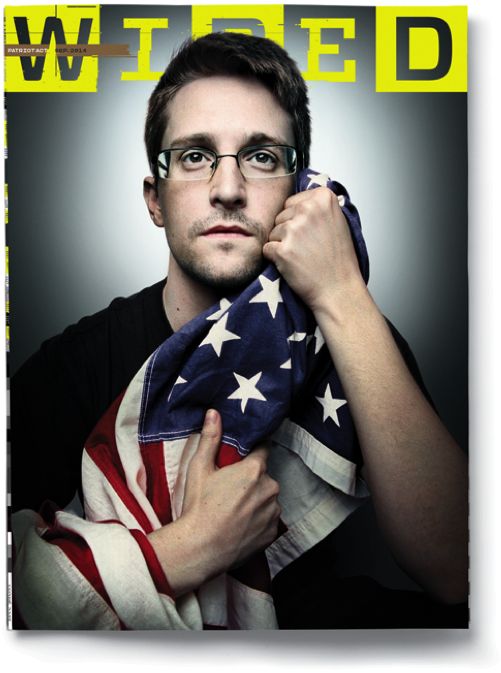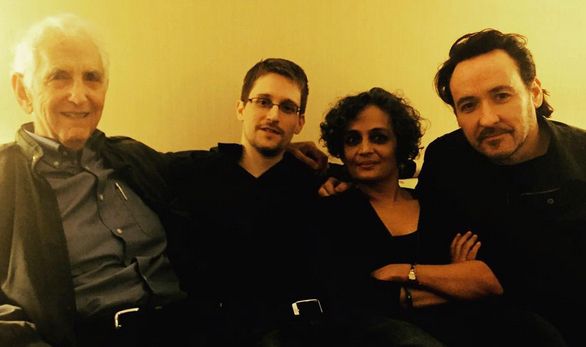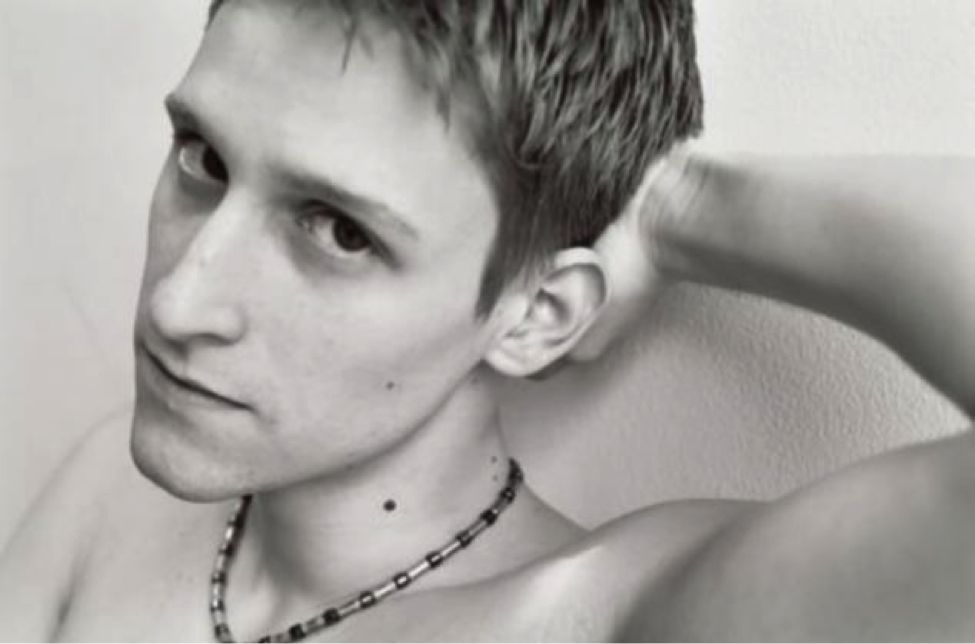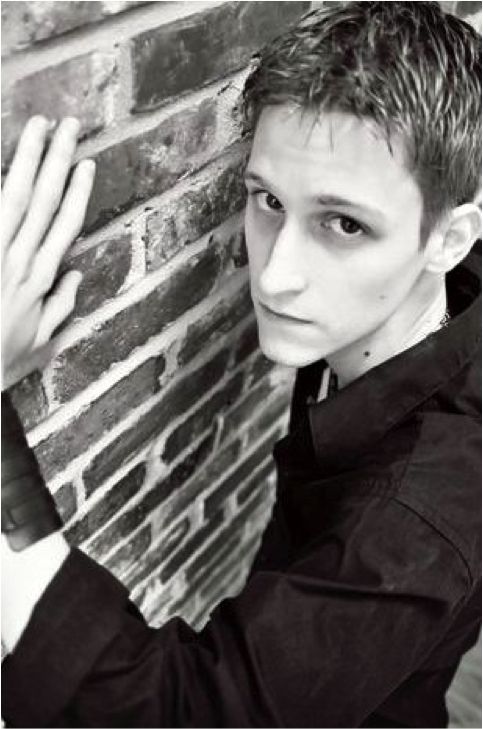The Whistleblower Fantasy
Dorothy Howard

“Edward Snowden, Won’t You Be My Valentine?” Huffington Post. 2015.
On an August 2014 cover of Wired magazine, Edward Snowden squeezed an American flag in a pose somewhere between cutesy and suggestive. The headline calls him “The Most Wanted Man in the World.” The contrast of innuendo and patriotism in this image calls attention to a widely raised question–is Edward Snowden an American hero? Snowden’s subtle sexualization has certainly been a repeated occurrence in the major news media. This coverage might be written off as the media’s attempts to indiscriminately “sex up” headlines in a fierce, online attention economy. Still, you can tell a lot from media allegory, and the figure of the whistleblower is no exception. A new type of celebrity was created in light of the increasingly visible police state, and rising cultural consciousness about global information politics. What remains to be seen is if this sexualization of Edward Snowden will lead to positive media attention on the rising political issue of mass surveillance, or if the contemporary news media’s tendency to heroize individuals dilutes the public’s sense of political immediacy.

August 2014 cover of Wired magazine.
The whistleblower is an archetype for a widely understood social choreography that has existed for decades, long before protests of mass surveillance like Wikileaks came to the scene. The term whistleblower goes back to a nickname for the late 19th century police force, who began using whistles to alert citizens that purported criminals were nearby. The word was détourned by later generations, reportedly around the 1960s, to mean resistance to information policing. In recent years, the whistleblower has been most widely associated with figures calling attention to state-sponsored surveillance programs. Digital rights advocates, among them Aaron Swartz, Julian Assange, Chelsea Manning, and Edward Snowden have risen to the global media stage as superheroes fighting off one of the contemporary world’s major evils–dataveillance.
Snowden’s status as an information activist hero brought him to widespread recognition and he became a regular feature of news cycles. We can use Snowden’s rise to popularity as a way to understand how the media, once it identifies a target, treats famous people in a similar way–whether they rose to the public eye because of politics, music, or reality TV. Anna Watkins-Fisher’s article, “We love this Trainwreck!: Sacrificing Britney to Save America,” describes this phenomenon, using the example of the synchronous media treatment of Britney Spears and George Bush. According to Watkins-Fisher, both were global media icons of cultural ‘excess’ and ‘failure’ in the early 2000s, both figures were often parodied as examples of destroyed American ethics. The converging, monopolistic platforms where we gather information about these figures–increasingly through feeds, Facebook, Buzzfeed, and Youtube in particular, help homogenize this coverage.
Robert Snowden with Daniel Ellsberg, Arundhati Roy, and John Cusak. The Guardian.
Watkins-Fisher’s thesis is demonstrated by a recent Guardian profile of Edward Snowden by novelist Arundhati Roy and actor John Cusak (why these celebs were able to get access still remains unclear), Snowden is asked about the juicy Wired cover photo:
Snowden’s disarming answer to my question about being photographed cradling the American flag was to roll his eyes and say: “Oh, man. I don’t know. Somebody handed me a flag, they took a picture.”
Snowden’s eye roll in this piece constitutes a narrative acknowledgement of the camp aesthetic of the cover photo pose, and perhaps more broadly the way his image has been de-contextualized, made into a symbol.

Citizenfour promotional advertisement.
Perhaps an aspect of the whistleblower’s ongoing intrigue in the media, in addition to the information they offer, is the fact that they are revealing something obscene (often a challenge to authority or government) which requires proof, as the result of a strong moral compass. The whistleblower represents an indivual putting their own ethics above protocol or systematic procedure. The whistleblower wears a uniform of power through their possession of a weapon of privilege; information. Is it this power that takes Snowden into ’hero’ status, or perhaps his other demographic privledge as a straight, white, male? While Snowden, and Assange have received "fangirl coverage," other whistleblowers like Chelsea Manning nonetheless have received negative media attention in what seems like an attempt to undermine her political credibility with off-point identity attacks?
Laura Poitras’ film Citizenfour (2014) set mostly in a hotel room like an Amalia Ulman Instagram photo-shoot, depicts Snowden lounging on his laptop in a sort of corporate purgatory, sometimes in nothing more than a robe. It represents a sort of popular exposure to the whistleblower, and the intimate hotel setting sets a tone found in other media depictions of whistleblowers presenting a sort of romantic view of the persona of the whistleblower. The film was heralded both in the mainstream film sector (winning an Academy Award for Best Documentary Feature) and by the art world– exhibiting at major venues like Artists Space (New York). “We’ll meet in the hallway, I’ll be working on a Rubik’s cube” is one slogan slapped onto promotional posters for Poitras’ film that sounds like a line from a Freddy Prince Jr. high school romantic comedy. The Rubik’s cube almost as a sex toy of those paranoid for dataveillance, a symbol of the genius needed to beat corrupt political systems.

Cooper Fleishman. "Photos from young Edward Snowden’s brief modeling career." Dailydot. June 13, 2013.

Cooper Fleishman. Dailydot.
Snowden’s chiseled face and stubble is the subject of much fan art on Tumblr and Deviantart ensconcing his cult of personality. A Google image search for him quickly reveals the category, “male model.” His brief modeling career has been replayed on internet gossip sites. The DailyDot has reported that the Internet Archive’s Wayback Machine reveals the text posted by an 18-year old Snowden when he added these photos to an Ars Technica forum:
So I got invited to model for this guy (potentially NSFW) last week, and I just now got the proofs back from him. He shoots mostly guys, and he’s got some... "questionable" people interested in his work, so I was actually a little worried he might, you know, try to pull my pants off and choke me to death with them, but he turned out to be legit and is a pretty damn good model photographer.
It’s only my third shoot, so be gentle.
The 'outing' of such photos is to be expected based on Snowden’s participation in internet culture, posting on forums, etc. Yet when porn is used to disclaim or defile a public persona, it often backfires, creating more of a media spectacle around the subject, whether the coverage is negative or positive.
Another obvious trope in the media about Snowden has been the focus on his relationship status, kindling for the gossip column crowd. A January 16th, 2015 Tweet of Snowden’s was also revealing of his fan attention: “The "Christmas presents" are flattering, ladies, but the FBI has a warrant. #AndIHaveAGirl.”

Snowden’s girlfriend Lindsay Mills who was depicted with him happily in Russia at the end of Laura Poitras’ film Citizenfour (2014) is also a growing icon as a social media fitspiration model. Her sexy pictures are one of the first thing that comes up in a simple Google Search for Snowden, and the couple has become the stuff of clickbait gossip fodder and fan art montages. Together they make something of a social media power couple, whose images have been endlessly repurposed into GIFs and memes. That Snowden “has a girlfriend” is irrelevant, blogs continue to portray Snowden’s “heartthrob” qualities. “Edward Snowden, Won’t You Be My Valentine?” reads a February 11, 2015 headline. Celeb Joseph Gordon-Levitt was also recently cast in Snowden, an upcoming Oliver Stone Hollywood dramatization out in May, 2016.

Edward Snowden and Lindsay Mills collage found online.
Edward Snowden’s celebrity has certainly risen as a product of the topic of surveillance affecting pretty much every conceivable aspect of life and industry. He appeared remotely by proxy from Russia at SXSW in March, 2014; by Beam, a $16,000 telepresence robot at TED 2014; at the Consumer Electronic Show (CES) in Las Vegas on January 7, 2016 also through Beam. Word has it that Snowden also has a permanent Beam bot at the ACLU offices. Ben Wizner, Snowden’s lead lawyer said to Forbes in June, 2014: “The telepresence robot is a “disruptive technology that is a profound response to exile.. You assume it’s just going to be Skype on wheels, but it’s actually much more intimate than that for both the person operating it and for the people in the room with it because the camera is so good and because it moves independently.” Audiences get a kick out of the fact that their livestream is taking a political risk, that proxies are involved, and event organizers see it as an opportunity to promote a slew of virtual meeting technologies, like Snowden’s recent Beam sponsorship.
Martyr armor


Why do we need individual heroes at the center of digital rights conversations? One might look to Leo Steinberg’s famous art historical text, The Sexuality of Christ In Renaissance Art and in Modern Oblivion, to interpret this phenomenon. The body has long been a symbol of the mind. Christ’s body in particular, has been used in the history of art as symbol of a sort of fertility or historical strength of the institution of Christianity. Steinberg argues a modernist interpretation, that there was a rise in depictions of a naked, human Christ, as an infant, and adult, as well as other religious figures, like cherubs, baby angels, during the Franciscan order around 1260 because of a rising acceptance of sexuality in daily life. A New Yorker article by Lee Siegel celebrating the book 30 years after its publication summarizes some of its main observations:
Many representations of the Three Magi show one of the foreign kings closely inspecting the infant Christ’s genitalia. Depictions of Christ on the cross and of the dead Christ lying in the Virgin’s arms clearly portray Christ with an erection.
In some images, which Steinberg calls “psychologically troubling,” the divine Father touches his Son’s penis, “a conciliation,” Steinberg writes, “which stands for the atonement, the being-at-one, of man and God. For this atonement, on which hinges the Christian hope of salvation, Northern Renaissance art found the painfully intimate metaphor of the Father’s hand on the groin of the Son, breaching a universal taboo as the fittest symbol of reconcilement.

The archetype of the whistleblower might also be characterized as a martyr, sharing a symbolic association with the willingness to sacrifice the self for ideological beliefs. In this way, the whistleblower’s whistle stands for an object representing a sort of sexualized salvation from the ubiquitous evil dealings of the internet’s major players like Google. The word itself implies the mouth, in order to be a whistleblower one has to blow.
Then again not every depiction of Snowden is heroic. A central binary of the media coverage has been the “hero or traitor” question. While politicians have tread a careful line, as endorsing Snowden might be construed as treasonous, at the same time, he uncovered unlawful governmental surveillance programs that shouldn’t have been operating in the first place. Senator Bernie Sanders told MSNBC: ”He did break the law, and I think there should be a penalty to that. But I think what he did in educating us should be taken into consideration,” perhaps the strongest endorsement that a politician could make.
The web has many problems and vigilantes and whistleblowers have taken things into their own hands. Through a combination of charisma and infamous acts, disputed for their criminality, these figures have risen to celebrity. But let’s hope that our media coverage isn’t a distraction to the real issues at play. *~
Dorothy Howard is a technology and media researcher, writer, and information activist. She focuses on digital labor, contemporary art, and online culture. Her first book of poetry, Troll was published by Inpatient Press (2015).